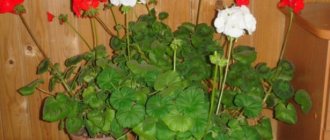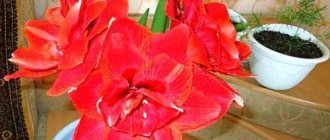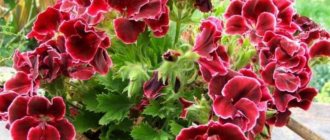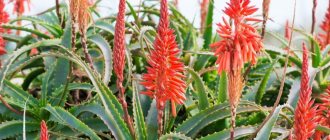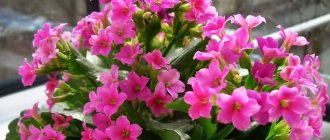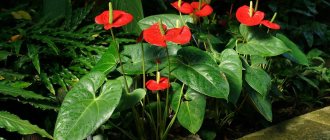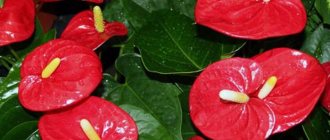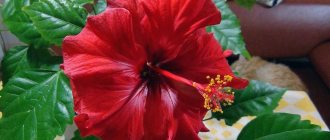Geranium flowering conditions
Pelargonium is unpretentious to the conditions of detention. But in order to achieve abundant flowering, you need to follow a number of simple rules.
Temperature
The most comfortable temperature for geraniums is room temperature. That is, 20-23 degrees.
Air humidity
The plant does not like humid air in the room, so keep it in a dry room. If there is high humidity in your house or apartment, then place the flower by the window.
Lighting
Geranium on a windowsill on the sunny side
Geranium loves warmth and light. But at the same time, you need to take care to protect the plant from direct sunlight. Pelargonium will not “burn” from the midday heat, but the flowers will fade faster.
Therefore, on the windowsill, do not place the geranium close to the glass, but move it a little further to the edge.
Location
Geranium feels best on window sills, balconies and verandas. Some gardeners even plant flowers in the garden and flower beds for the summer.
Soil features
Geranium can be planted in neutral, acidic and slightly acidic soil. The plant is generally not picky about soil. The main thing is that the soil is loose. In addition, you must take care of drainage so that moisture does not accumulate in the pot.
Pot
Geraniums need to be grown in a small pot. If the flower has a lot of space, it will gain green and root mass. Geraniums should be crowded.
CLUE.
If you have a large pot empty, then plant several plants in it at once.
The necessary conditions
For long and abundant flowering, several conditions must be met:
- Comfortable temperature for flowering pelargonium is 22–27 degrees.
- The plant prefers tight pots with light, water- and breathable soil.
- The flower loves a lot of light, bright but diffused.
- Does not tolerate stagnant moisture; watering is rare, but abundant and regular. Between waterings, the soil ball should dry out by half.
- You should regularly pick off wilted inflorescences and yellow leaves.
- At the beginning of growth, pinch over the fifth leaf of each shoot to ensure proper formation of the bush.
- Do not overfeed with nitrogen fertilizers; potassium and phosphorus are preferable for flowering.
- Daylight hours during this period should be 12–14 hours.
Spraying the leaves is not recommended. In winter, the plant should be at rest at a temperature of 10–14 degrees. in order to accumulate strength for the next seasonal flowering. If there is no dormant period, the number of inflorescences decreases and the flowers become smaller. The bush loses its decorative effect.
Why doesn't it bloom at home?
There are several main reasons why your pelargonium does not bloom.
Geranium bush without flowers
- Insufficient amount of fertilizer. Geraniums need to be fed once every 7-10 days.
- Incorrect feeding. The plant loves potassium fertilizers and does not tolerate organic matter well.
- Excessive watering. It is very important not to flood the flower. Otherwise its roots will rot.
- Lots of free space. In order for a plant to bloom, it needs to create close conditions.
- Too many neighbors. Geranium tolerates “cohabitation” well with other flowers, but it’s still not worth creating a whole flower garden in one pot.
- You forgot about pruning in the spring. Before the start of the new season, the old flower must be thinned out well and no more than 2 shoots should be left.
- Little light. Geranium is a light-loving plant. Therefore, it needs to be provided with a sufficient amount of sun. But it is advisable not to expose the plant to direct sunlight.
- Unsuitable temperature. If the place where the geranium is located is too cold or too hot, the plant may not bloom.
- The plant is too old. If your flower is many years old, then the reason may be the age of the pelargonium.
- It's winter outside. In winter, geranium prefers to rest. If it’s frosty outside, then just let the flower rest until spring.
Types of geraniums
Geranium is a plant that was brought to Russia from South Africa. This fully explains its unpretentious nature. In his homeland, the climate is quite harsh, with sudden temperature changes and strong winds.
Initially, there were several varieties of geranium, but later, using the hybridization method, botany developed many varieties with different shapes of peduncles and a rich palette of petal shades.
Room
The most popular type of geranium for home growing. Of all the species, it is the most unpretentious and can grow not only indoors, but also outdoors: in a flower bed, terrace, greenhouses and beds.
A traditional indoor plant, its smell repels flies and other domestic insects
Royal
It has a branched bush shape, a wide peduncle and a wide variety of shades in the inflorescence. Unlike other types of pelargonium, royal pelargonium requires special care and attention.
Many gardeners plant outdoor varieties to repel insect pests in the area
Ampelnaya
In terms of unpretentiousness, it is close to indoor plants, but has a slightly different structure of the stem and branches. More often used for planting in hanging pots, decorating greenhouses and in combination with other decorative elements. The flowers are small and exquisite.
Ampelous geranium is a favorite of landscape designers; thanks to its elegant appearance, it is a great soloist in wall compositions.
Terry
It differs from other types of geranium in the shape and texture of the petals. They are terry to the touch. This variety does not like getting wet - it can cause the flower to rot.
Geranium purifies the air in the house, destroying harmful bacteria, and has a phytoncidal effect.
Rose-shaped
A pelargonium hybrid that resembles small roses in appearance. It grows successfully from seeds and blooms profusely in the first year of life.
An aromatic pillow with dry geranium leaves will help cope with insomnia
Tulip-shaped
The flowers in the peduncle of this type of geranium are larger than those of others. Outwardly it resembles a tulip flower and that is why it has such a name.
Ice cubes with geranium juice will help maintain youthful and elastic skin
What should I do to make it bloom?
Sometimes it happens that even with proper care, geraniums do not bloom. In this case, you need to take extreme measures. Their essence is to create the most unsuitable conditions for the plant.
Here are some possible methods:
- Trim the bushes even further. Leave only 2 eyes on one shoot.
- Place the geranium in the cold and reduce the amount of water.
- Replant the plant.
- Increase the concentration of iodine in the supplement.
Trimmed geranium bushes
How to do this correctly?
To properly pinch geraniums, you need to do the following:
First of all, you should carefully examine the shoot, which needs to be stopped in growth. The largest bud is found on it - this is the growth point, which is responsible for the active development of the flower. If you do not remove the bud at the top of the stem, it will continue to grow in height, but lateral shoots will not form. Find the main bud on the top of the head, carefully pinch it with clean hands; if the stem is already woody, you can take small scissors or a stationery knife and cut it
The operation must be carried out carefully so as not to damage the young leaves nearby and not to break the stem. It is worth understanding that after a certain time, the main stem will continue to grow upward, but while it adapts, side buds will awaken on it and give off branches. To form a bush, you should watch where the buds wake up first. If the shoots begin to grow in the wrong place where you need them, they are removed completely, then the buds you need will begin to produce layering.
In addition, it is worth paying attention to the following nuances:
- The tools that will be used for pinching must be disinfected - it is advisable to use alcohol. In addition, scissors or pruning shears should be sharpened, and it is better to take a new blade for a stationery knife so as not to unnecessarily injure the geranium. Hands should also be sanitized to prevent third-party infection.
- If no tool is used when pinching geraniums, then try not to pull the plant by the shoot, this will injure it and it will take a lot of time to recover.
- Once all procedures are completed, the plant is transferred to a warm, well-lit place. In order for young cuttings to develop well, they need a lot of sunlight and warmth.
- If unhealthy shoots appear on the geranium, they are immediately removed along with a portion of the healthy shoot, approximately 2-4 cm.
- Places of cuts and pinching must be treated with antiseptic agents. This could be brilliant green, wood ash, activated carbon. If this is not done, the plant may get sick or begin to dry out from the cut site.
If you do everything correctly, the geranium will soon delight you with new shoots.
To make it thicker
In order to ultimately get a flowering compact bush on the windowsill, the top bud should be removed from the main shoot.
At the same time, the growth of the plant stops, it begins to gain strength to awaken the lateral growth points. If the stems begin to grow from the bottom of the main stem, they should be removed so that the plant gets a spherical shape.
So as not to grow upward
To stop the growth of geraniums, the upper part of the stem is removed. But sometimes it happens that after this procedure, layering begins to grow at the top of the main stem - they need to be removed.
The shoots that grow along the stem must also be pinched at the top point of growth so that they do not grow higher than the shortened main stem. If buds appear on the flower at this time, they should also be removed immediately, otherwise the side shoots will be thin and weak.
Blossomed luxuriantly
It is worth understanding that only young layers of geraniums gain color, therefore, to obtain a lushly flowering plant, you need to systematically pinch it. 5 leaves are left on the young layer, the rest is removed. On all shortened cuttings, lateral buds will begin to wake up, and as a result, a magnificent plant with a lush, flowering crown will show off on the windowsill.
Pinching a plant grown from seed
If geranium is planted with seeds, then pinching begins as soon as 6-8 pairs of true leaves are formed on the young plant. In addition, only axillary layers that form from the bottom of the main stem should be left on young geraniums. Layers from the top should be ruthlessly removed.
Anyone who grows geranium or is just planning to do so will benefit from our experts’ materials on feeding the flower, including iodine, on choosing soil and pot, as well as how to properly replant and plant the plant.
Care after flowering
If your pelargonium blooms only in the warm season, then you need to know a few simple rules for caring for the plant after flowering.
- If you took a flower pot outside for the summer, then do not rush to put it back. Keep your pet in quarantine for a whole month to make sure that he is not sick and will not infect his neighbors.
- During the dormant period, geraniums should be kept cool (temperature about 15 degrees).
- The frequency of watering also needs to be reduced.
- Do not keep the flower in a warm, humid room.
Features of flowering
Flowering is a method of reproduction. During the period of swelling of flower buds, the formation of flowers, and the formation of pollen, pelargonium (and all plants) consumes the greatest amount of energy, and the processes of metabolism and absorption of useful substances are accelerated.
When and for how long does the plant bloom?
With proper care, pelargonium blooms up to 6 times per season, from spring to late autumn, opening buds again and again, which remain decorative for 20 days. The bush remains attractive for up to 5 years, and with proper care, including proper pruning and dormant periods, it can remain decorative for 10 years.
How to water?
Pelargonium does not like a lot of water. Make sure there is no excess moisture in the soil. Therefore, be sure to provide the plant with good drainage. Water from a regular plastic bottle along the walls of the pot. This will prevent water from getting on the leaves and stems.
The water should be at room temperature and not hard. To do this, you can filter the liquid or let it settle.
The frequency of watering geraniums depends on the season:
- Spring . You need to water the flower when the soil dries out by about 10 mm. Check the humidity with your finger, toothpick or pencil. If all plant care conditions are met, the soil will dry out in about 3 days .
- In summer, pelargonium's need for moisture increases. You can even water it daily . The main thing is to be careful not to “flood” the geranium. Remember that the soil must be dry before watering.
- In autumn, geraniums need to be watered less often than in summer. After flowering ends, the interval between waterings should be 2-3 days . This will prevent the plant roots from drying out.
- The dormant period for geranium begins in late autumn , at the end of October - beginning of November with the arrival of the first cold weather. If there is a thaw outside, then you need to water the plant at intervals of 12-14 days. If there is severe frost outside, then moisten the soil every 10-12 days.
“Wintering” lasts until the beginning of spring.
IMPORTANT!
Remember that for geraniums it is better if the soil is dry than too wet. If a flower doesn’t have enough water, you can tell by its dry edges. From excessive watering, geranium becomes lethargic, and the leaves begin to turn yellow and wither.
How to care?
Caring for the beautiful pelargonium is not difficult, but it must be done regularly.
Caring for a plant includes several mandatory conditions:
- do not overdo it with watering;
- carry out timely pruning;
- observe a rest period in winter;
- feed regularly in spring and summer;
- observe light and temperature conditions.
Watering
From spring to autumn, you need to water the flower when the clod of earth is half dry, this is approximately once every 7-10 days, without touching the leaves and flowers. Excess water from the pan should be removed. No need to spray. If the air in the room is dry, place a bowl of water next to the pot. In winter, water only when the soil is completely dry.
Do not use hard water for irrigation. Replace with boiled or bottled water.
Light mode
From spring to early autumn, pelargonium should be placed on southern and south-eastern windows. Daylight hours are 12–14 hours. In this case, direct sun should be avoided. The light should be diffused . To do this, you need to move the pots a meter from the window and shade the flowers with transparent curtains. In winter it is a bright place with short daylight hours.
Feeding
After planting, pelargonium can be fed with nitrogen fertilizers so that the bush increases its biomass. During the flowering period, it should be fed 3 times a month with potassium-phosphorus fertilizers. You can use a fertilizer produced specifically for pelargoniums or for flowering plants. In winter, the plant does not need to be fertilized.
Temperature
Spring – summer – early autumn, when pelargonium blooms, the optimal temperature is 22–27 degrees. In winter, at rest, 10–15 degrees.
Trimming and pinching
Before winter, pruning or pinching should be done. As a rule, young plants are pinched. This is done like this: the top of each shoot is pinched or cut off so that 5 leaves remain on the shoot. Bushes older than 2 years are regularly pruned. This is a very important procedure for abundant flowering:
- forms a beautiful bush;
- increases the number of inflorescences;
- prolongs flowering time.
Pelargonium is trimmed immediately after flowering in two ways:
- up to the 7th dormant bud;
- up to 3 buds, that is, per stump.
The choice of method depends on the condition of the bush. Young bushes can be pinched up to the 7th bud. Bushes that have become woody are pruned into a “stump.”
Before pruning, the plant should not be watered so that juices do not ooze from the cuts. Disinfect the cut areas with brilliant green or charcoal. After pruning, do not water for 1-2 days, then water and place in a bright place. The plant may have to be pinched in the spring; during the winter, if there is insufficient light, it may stretch out.
Rest period
Pelargonium is at rest from December to early spring. She does not need feeding at this time. During this period, plants are watered only when the earthen ball dries out completely. Pelargonium grows well and develops in winter, growing branches and leaves. The temperature should be at least 7 degrees, there is a lot of light, the daylight hours are short.
Errors during transplantation
- Drainage is not installed. It is better to use fine expanded clay as drainage. You can buy it at any garden supply store.
- The plant was not watered before transplanting. To remove pelargonium from an old pot without damaging the roots, water it more than usual.
- The voids in the new pot are not removed. The empty space must be filled with slightly moistened soil. Lightly press down the soil so that there are no voids left. In this case, under no circumstances should you compact the soil!
- First watering too early after transplantation. The flower should be watered no earlier than every 4 days.
IMPORTANT!
Don't forget to make holes in the bottom of the pot if there aren't any.
If the geranium does not bloom
There are several factors that explain why geraniums do not bloom. When a pleasant aroma does not spread throughout the house, it means that one of the rules for caring for the plant has been violated. Most often, this is affected by the lack of a wintering period, which the plant needs to get stronger and gain strength for new buds.
Note! In the cold season, geraniums are moved to a room with a temperature of about 10 degrees. During this period, watering is reduced and light is provided in moderate quantities. The plant requires sunlight or an artificial alternative for several hours a day.
Blooming geranium
There are other reasons, studying which will help you understand what to do if geranium does not bloom.
Pinching bushes
Pelargonium needs to be pinched. The procedure is required to:
- Get rid of diseased leaves and branches that do not allow geraniums to grow to their full potential;
- Accelerate the flowering of the plant and make it more lush and vibrant.
Usually the tops of the geranium stem are cut off. You need to remove leaves from the branch, leaving no more than five. Then the plant will send out more young shoots and become livelier and brighter.
It is necessary to find the top growing point or bud on the stem and remove it. This is where most of the shoots come from. You can remove it with your fingers or scissors if the stem is hard. If left, the flower will stretch upward, since the side shoots will not have time to form. After removal, shoots will begin to form on the sides, so the plant will become more luxuriant. At this time, geraniums require a lot of heat and sun to give strength to new leaves and speed up their formation.
The pinched growth point is treated. For this use:
- activated carbon, crushed to a powder;
- brilliant green;
- alcohol;
- mustard powder;
- ash.
This is necessary to disinfect the plant, speed up healing and protect against the spread of possible infection.
Note! After some time, the pinched growth point will sprout again. You need to carefully observe them and adjust the shape of the flower so that it does not stretch upward. Pinching is usually carried out several times a month. The exception is the wintering period, when they try not to disturb the plant again.
Plant pruning
Pruning removes entire geranium branches, usually those that grow inward. You need to find a leaf node and cut 3-5 millimeters above it. To do this, you need to use a sharp knife that has been disinfected in advance. You can wipe it with alcohol or pour boiling water over it.
Geranium pruning
It is not recommended to use scissors for pruning, as they pinch and injure the branch. The affected area is sprinkled with an antibacterial agent.
Note! Pruning will help to obtain a lush bush, will not allow it to stretch in height, and it will bloom profusely. After the procedure, the buds usually appear larger.
You need to prune several times a year:
- In winter, before the plant goes into hibernation. This is a planned procedure designed to prepare geraniums for dormancy. Remove wilted leaves, dry branches and flowers. During rest, the plant does not need to waste energy restoring the yellowed crown;
- In spring, to prepare geraniums for flowering. It is used to give it a beautiful shape and get more buds;
We must remember! The procedure slows down flowering, moving it to a later date, but the flowers will be larger.
- In the summer, as dry branches and leaves appear, in order to conserve the plant’s strength and direct it to the growth of young shoots.
The need for transplants
It is believed that geranium grown at home does not need to be replanted if it grows, blooms and looks healthy. Trimming and pinching is enough. There are cases when you need to replant a plant. For example, if it was not touched after purchase, the pot became too small for the flower. Then there is not enough space for the roots and the plant does not develop normally. This may be one of the reasons for the lack of flowering.
Urgent replanting is required if the plant's roots are visible in the drainage holes. In this case, the size of the pot should be 2-3 centimeters larger in diameter than the previous one. If a geranium is moved into a huge pot, the roots will begin to develop rapidly, taking away all the vitality, while the crown will not be lush enough.
It is also necessary to replant the plant when it is over-watered, when a large amount of moisture has accumulated and the process of decay has begun. The foliage will begin to wither and turn yellow. This can be avoided by using drainage lined at the bottom of the pot.
The material used for it is:
- expanded clay;
- broken red brick;
- fragments of pottery;
- Styrofoam.
Drainage
The drainage is laid out to a height of 2-3 centimeters. Before transplanting, the plant must be watered abundantly one day before the procedure. Thanks to this, geranium can be easily removed from the pot without damaging the roots. Together with the soil, it is transferred to a new pot. If there are affected areas of roots, they are carefully removed with a sharp sterile instrument. Then the soil is filled in, which needs to be moistened in advance. You need to lay it until the emptiness in the pot disappears.
Temperature compliance
The birthplace of geranium is South Africa, so the flower is accustomed to a tropical climate. Incorrect temperature conditions affect the health of the plant and manifest itself in the absence of flowering. In spring and summer, pelargonium prefers temperatures no higher than 22 degrees. In winter it lies dormant in a cool room. It is important that the temperature is below 15 degrees, the minimum limit is 10.
Important! There is no need to create coolness by ventilation and spraying. Geranium does not tolerate drafts and requires minimal soil moisture in the cold season. The leaves don't need this at all. It is not recommended to even wipe them with a damp cloth.
Fertilizers to stimulate flowering
During its flowering period, geranium loves a variety of feedings. However, care must be taken when choosing the appropriate drug.
Drugs
Geranium does not like organic fertilizers and does not bloom when only nitrogen fertilizers are applied. In a complex fertilizer, the share of nitrogen should not exceed 10%.
It is best to use fertilizers based on potassium and phosphorus, as well as magnesium sulfate.
Homemade fertilizer recipes
Feeding with iodine
An iodine solution can stimulate plant flowering. Mixing proportions: 1 drop per 1 liter of water. It is worth feeding with iodine 4-5 times throughout the summer. When you water the color with the solution, be careful not to get it on the leaves or stems.
Feeding with boric acid
To make geraniums appear new inflorescences, you can use boric acid. To do this, dissolve 0.5 g of powder in 1 liter of warm water. Water according to the feeding schedule with iodine water.
Aftercare rules
In order for geranium to grow and bloom well, it needs to be properly cared for throughout the year, knowing all the features of this flower. The most important moment of development is spring awakening, when the bush is actively growing. At this moment, you need to help the plant as much as possible and apply suitable mineral fertilizers.
It is important that the amount of nitrogen is not more than 11%, because high levels will contribute to the appearance of exclusively greenery, without any flowering
Once consistently warm weather sets in, the flower is transferred to open ground or to the balcony. Due to the difference in temperature between day and night, the flower becomes active and begins to produce a large number of buds. For abundant flowering, it is worth picking off or trimming those inflorescences that have already withered.
Another important stage in the normal development and care of a plant is its pruning. Regulating greenery and cutting off old stems helps the bush to bloom; you should not carry out these activities only with royal geraniums, pruning is too stressful for them. The procedure for removing unnecessary parts of the plant is carried out in the fall, and at the end of winter you need to pinch the bush, which in the future will allow the geranium to bloom profusely.
The plant can be pruned in either autumn or spring, and the procedure will be different. Autumn pruning will look like this:
- remove all faded inflorescences, wilted leaves and stems;
- decide on the shape of the bush and remove all unnecessary shoots;
- remove very long shoots or shoots without leaves - it is better to cut near the lower node; if you leave a stump near it, then new shoots will appear from it later;
- in preparation for winter, it is worth cutting the main stem by a third of its length;
- The pruning procedure is not performed in winter, as the plant is dormant.
If we talk about spring pruning, then it is a mandatory event, because it allows you to renew the greenery and give impetus to the formation of flower stalks. Due to spring pruning, the flowering period is delayed for a couple of weeks, but in the end the flowers grow larger and more beautiful. It is recommended to carry out these activities at the end of winter or beginning of spring.
If the bush is large, it is not recommended to prune it heavily, because it will take a lot of time to recuperate, and this may result in a complete lack of color. If the bush is young and small, then it can be shaped as desired, without harming its development. The main criterion for pruning will be the presence of at least two buds on the plant.
To create optimal conditions, the flower should be transplanted into open ground, so caring for it will be easier, and natural conditions will promote active growth and flowering. The time for transplantation is quite easy to determine; the main factor is the absence of significant temperature changes during the day or night. By autumn, it is worth planting the geranium in a pot again, pruning it heavily so that the bush begins to prepare for winter. Organizing a cool temperature will enable pelargonium to gain strength over the winter and actively begin to grow with the onset of spring.
As for care during flowering, it should be as correct as possible so that this process takes longer. Watering and fertilizing, which are carried out in a timely manner, are important. If you give a flower maximum time and attention, you can easily understand exactly how to care for it.
- If the leaves begin to turn yellow and fall off, it means that watering is insufficient and needs to be increased. It is worth assessing the humidity and temperature of the room in which the flower is located and adjusting the amount of moisture introduced.
- If the foliage begins to wither and rot, then this is an indicator of excessive flooding of the flower. The solution in this situation is to stop watering for a while and place the pot in the sun.
- The edges of the foliage begin to turn red due to exposure to cold. The flower can be located very close to the glass in winter, causing the leaves to freeze. It is worth moving the pot further away to protect the crown.
- The foliage thins, falls off, exposing the stem - all these are reasons for the lack of light. You can solve the problem by moving the pot to a windowsill that is better illuminated by the sun.
To learn why geraniums don’t bloom and what to do, watch the following video.
Answers on questions
Why does it only produce leaves?
The reason is that the pot size is too large. The plant spends all its resources on the growth of roots, stems and leaves.
Some of the buds have dried up
If the buds dry out, then the plant lacks vitamins and minerals. Fertilize. Another reason could be stress due to a change of location or a change in temperature.
The plant has stretched out
If pelargonium has stretched out and lost volume, it means it does not have enough light.
Leaves curl at the edges
Most likely your pet is experiencing a lack of moisture.
Pelargonium Angel - what kind of flower is it
The genus Pelargonium belongs to the Geraniaceae family. This crop originally appeared in the tropical and subtropical climate of Africa.
This family, in addition to the royal geranium Angel, also includes other popular varieties - for example, Tip Top Duo. Representatives of the Pak variety series are especially popular today. These include varieties Bicolor and Viola.
Pelargonium is characterized by abundant and lush flowering
Brief description, history of origin or selection
If a flower lover grows Angels pelargonium, the varieties can be very different. All of them appeared by combining the royal and curly types. This happened at the beginning of the 20th century. The culture owes its appearance to the English breeder Arthur Langley-Smith.
Angelic culture is a plant 30-60 cm high. The bush is characterized by woody, not very wide stems with a large number of leaves. Some species are covered with small hairs with a fresh scent.
Important! The buds have an elongated shape with sharp ends. They resemble violets or pansies.
A distinctive feature of the culture is the difference between the color of the upper and lower petals. There are different color combinations - pink, scarlet, burgundy. White, lilac, purple tones are also possible. Often they are painted in 2 colors.
Common mistakes
- Geranium leaves do not need to be washed or sprayed. This causes them to turn yellow and dry out.
- You have placed the plant incorrectly. Do not hide it in the shade or expose it to the scorching summer sun.
- You have chosen the wrong pot. The peculiarity of geranium is that until its roots fill the entire space, there will be no flowering. Therefore, use small pots and planters. If you don’t have a suitable one, then add other plants to the geranium.
- No need to feed with nitrogen-based fertilizers. From them, the plant gains green mass and does not bloom.
- You have pruned your pelargonium incorrectly. You need to shorten the flower 2 times a year, in spring and autumn. This is necessary so that the bush retains its aesthetic appearance.
Withered geranium leaf
How to make geraniums bloom profusely regularly
Why cyclamen does not bloom at home and what to do
It is not enough to know why geraniums do not bloom; it is important to understand what to do in such a situation. Timely elimination of interfering factors will lead to the plant blooming. The main thing is to restore proper care.
Troubleshooting
First of all, you need to carefully examine the leaves of the plant. Often the first symptoms of disease or pests can be seen on the inside of the leaf. Most often geraniums are attacked by aphids and whiteflies. With timely treatment with fungicides, the problem is eliminated.
It is necessary to check the growing conditions of the plant. In some cases, to obtain abundant flowering, it is enough to move the flower pot to another window, where more sunlight falls, and the shoots will not stretch out much. In winter, it is recommended to use special lamps.
To get buds, you need to stop watering the plant abundantly. This will stimulate the appearance of new inflorescences.
What to feed
Feeding is a prerequisite for obtaining large inflorescences. Starting in March, geraniums are in the vegetative stage, so it is very important to apply the right fertilizers. Nessesary to use:
- potash fertilizers;
- phosphorus;
- nitrogen substances.
Wood ash can be used as nitrogen fertilizer. To prepare the working solution, you need to dissolve 100 g of ash in a liter of water. The resulting solution is watered onto a bush or potted flower. For young plants, ash is used in the amount of 50 g per 1 liter of water.
Fertilizer application
In mid-summer, you can feed the plant using a complex fertilizer for indoor plants. If geranium is grown at home, in the fall it is necessary to reduce the application of fertilizing and allow the plant to go into hibernation mode.
Important! It is not recommended to use mullein and chicken droppings as fertilizers. Such substances harm the roots and, when used indoors, can cause discomfort to residents.
Pruning and replanting
For abundant flowering, it is very important to regularly prune the bushes. Pinching shoots should be done in early spring or autumn. Features of pruning for each period:
- Spring pruning. The procedure is carried out in March. It is necessary to prune old shoots. The knife must first be disinfected. In the first few weeks after pruning, the plant will not grow green mass. However, such actions will provoke the appearance of large buds.
- Autumn pruning. The time for the procedure is the end of September, after flowering. First, sanitary pruning of damaged shoots is carried out. After this, it is necessary to shorten weak and old shoots. Often, with the help of autumn pruning, the bush is given the desired shape.
Plant pruning
It is recommended to replant the plant twice a year. In spring, geraniums can be planted in open ground or in a pot. Transplanting into a pot begins with choosing a container. The pot should completely contain the roots and have a small reserve. It is not recommended to take excessively large containers. A layer of drainage must be placed at the bottom of the pot. You can prepare the soil mixture yourself or purchase soil for indoor plants at the store. After transplantation, it is necessary to fertilize the geranium using potassium phosphate substances.
To stimulate flowering, the indoor plant can be temporarily transplanted into open ground. After this procedure, the geranium begins to actively grow and bloom profusely. After being in open ground, the plant develops resistance to temperature changes. You can plant the flower outside in the ground no earlier than mid-May. At the end of summer it is returned to the pot. This must be done before frost sets in.
